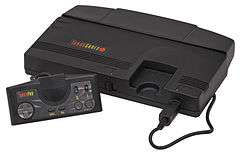TurboGrafx-16
  | |
|
Western markets model (top) and the original Japanese system (bottom). | |
| Manufacturer |
NEC Home Electronics Hudson Soft |
|---|---|
| Type | Home video game console |
| Generation | Fourth generation |
| Release date |
‹See Tfd› |
| Discontinued |
‹See Tfd› |
| Units sold |
Worldwide: 10 million[2] United States: 2.5 million[2] |
| Media | HuCard, CD-ROM (only with the CD-ROM² add-on) |
| CPU | Hudson Soft HuC6280 |
| Display |
Resolution: - max. 565×242 - majority: 256×239 Colors: - available: 512 (9-bit) - onscreen: max. 482 (241 background, 241 sprite) |
| Dimensions |
14 cm×14 cm×3.8 cm (5.5 in×5.5 in×1.5 in) |
| Successor | SuperGrafx |
The TurboGrafx-16 Entertainment SuperSystem, known in Japan and in France as the PC Engine (PCエンジン Pī Shī Enjin), is a home video game console jointly developed by Hudson Soft and NEC Home Electronics, released in Japan on October 30, 1987, in the United States on August 29, 1989, and in France on November 22, 1989. It was the first console released in the 16-bit era, albeit still utilizing an 8-bit CPU. Originally intended to compete with the Nintendo Entertainment System (NES), it ended up competing with the Sega Genesis, and later on the Super Nintendo Entertainment System (SNES).
The TurboGrafx-16 has an 8-bit CPU, a 16-bit video color encoder, and a 16-bit video display controller. The GPUs are capable of displaying 482 colors simultaneously, out of 512. With dimensions of 14 cm×14 cm×3.8 cm (5.5 in×5.5 in×1.5 in), the PC Engine once held the record for the world's smallest game console.[3]
In France, the system was released shortly after its American debut under its original Japanese name, PC Engine. In the United Kingdom, Telegames released a slightly altered version of the American model simply as the TurboGrafx in 1990 in extremely limited quantities.[4] This model was also released in Spain through selected retailers.[5] Although there was no full-scale PAL region release of the system, imported PC Engine consoles were largely available in France and Benelux through major retailers thanks to the unlicensed importer Sodipeng (Société de Distribution de la PC Engine, a subsidiary of Guillemot International).[6]
The TurboGrafx-16 failed to break into the North American market and sold poorly. However, in Japan the PC Engine was very successful. Two major revisions, the PC Engine SuperGrafx and the TurboDuo, were released in 1989 and 1991, respectively. The entire series was succeeded by the PC-FX in 1994, which was only released in Japan.
History
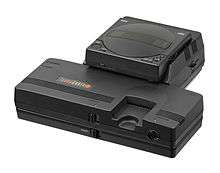
The TurboGrafx-16 was a collaborative effort between the relatively young Hudson Soft (founded in 1973) and NEC Home Electronics. NEC's interest in entering the lucrative video game market coincided with Hudson's failed attempt to sell designs for then-advanced graphics chips to Nintendo.[7]
The TurboGrafx-16 was the first video game console to have a CD-ROM peripheral, and first device ever to use CD-ROM as a storage medium for video games.[8][9][10][11] NEC released the CD-ROM² (シーディーロムロム Shī Dī Romu Romu, officially pronounced "CD-ROM-ROM") in Japan on December 4, 1988,[1][12] and released the TurboGrafx-CD in the United States on August 1, 1990.
The TurboGrafx-CD had a launch price of $399.99, and did not include any bundled games.[13] Fighting Street and Monster Lair were the TurboGrafx-CD launch titles; Ys Book I & II soon followed.
The TurboGrafx-series was the first video game console ever to have a contemporaneous fully self-contained portable counterpart, the Turbo Express, that contained identical hardware and played identical game software (utilizing HuCard format game software).
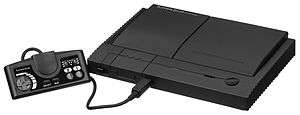
The TurboGrafx-16 was released in the New York City and Los Angeles test market in late August 1989. Initially, the TurboGrafx-16 was marketed as a direct competitor to the NES and early television ads touted the TG-16's superior graphics and sound. These ads featured a brief montage of the TG-16's launch titles: Blazing Lazers, China Warrior, Vigilante, Alien Crush, etc. The TG-16 was also in direct competition with the Sega Genesis, which had had its own New York/Los Angeles test-market launch two weeks prior, on August 14.[14] The Genesis launch was accompanied by an ad campaign mocking NEC's claim that the TurboGrafx-16 was the first 16-bit console.
NEC claimed that it had sold 750,000 TG-16 consoles in the United States, and 500,000 CD-ROM units worldwide, by March 1991.[15] That year NEC released the PC Engine Duo in Japan, a model which could play HuCards and CD-ROM² discs, making it the first game console with an integrated CD-ROM drive. The console was licensed to Turbo Technologies Incorporated, who released it in North America in 1992 as the TurboDuo. In addition to standard CD-ROM² format discs, the Duo could also play games in the newly introduced Super CD-ROM² format due to its greater RAM size (the TurboGrafx-16 and its CD player could support this new format only through the use of a separately available upgrade, the Super System Card, which TTI sold via mail order). The unit came into competition with the Sega CD, which was released almost immediately after. Turbo Technologies ran comic book ads featuring Johnny Turbo. The ads mocked Sega, and emphasized that though the TurboDuo and Sega CD had the same retail price, the TurboDuo was a standalone platform and included five pack-in games, whereas Sega CD buyers needed to purchase separately sold games and a Genesis console before they could use the system.
However, the North American console gaming market continued to be dominated by the Super NES and Genesis rather than the new CD-based consoles. In May 1994 Turbo Technologies announced that it was dropping support for the Duo, though it would continue to offer repairs for existing units and provide ongoing software releases through independent companies in the USA and Canada.[16]
The final commercialized release for the PC Engine was Dead of the Brain Part 1 & 2 on June 3, 1999.[17]
Variations
Several variations and related products of the PC Engine were released throughout the 1990s.
First-party models
 |
 |
| |
|
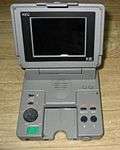 |
.jpg) |
| |
|
The TurboGrafx-CD, released as the CD-ROM² System (シーディーロムロムシステム Shī Dī Romu Romu Shisutemu, pronounced "CD-ROM-ROM") in Japan on December 4, 1988,[1] is an add-on console which, when attached to a standard TurboGrafx-16, can play CD games and audio CDs. It was followed by the Super CD-ROM² System (スーパーシーディーロムロムシステム Sūpā Shī Dī Romu Romu), which was released in Japan on December 13, 1991[1] as both: an add-on unit for the PC Engine with built-in BIOS, and as a Super System Card (スーパーシステムカード Sūpā Shisutemu Kādo) for the original CD-ROM² System, which adds 192KB of RAM required to play titles in Super CD-ROM² format. Certain games in Japan were released in a third disc format, the Arcade CD-ROM² (アーケードシーディーロムロム Ākēdo Shī Dī Romu Romu) (released in Japan on March 12, 1994),[1] requiring the use of an Arcade Card (アーケードカード Ākēdo Kādo). The Arcade Card was available in a "Pro" version designed solely for the original CD-ROM² System, and a "Duo" version that worked with the Super CD-ROM² System and all PC Engine Duo models (both adding a total of 2MB of RAM). These are not compatible with the TurboGrafx-16, nor with the TurboDuo, without an adapter.
The SuperGrafx (released in Japan on December 8, 1989)[1] is a variation of the standard PC-Engine hardware. This system is nearly identical to the original PC Engine, except it has a second HuC6270A (VDC), a HuC6202 (VDP) to combine the output of the two VDCs, four times as much RAM, twice as much video RAM, and a second layer/plane of scrolling. The CPU, sound, and color palette were not upgraded, making the expensive price tag a big disadvantage to the system. NEC also decided to not include the extra two video chips in the all-in-one Duo replacement system. Only five exclusive SuperGrafx games and two hybrid games (Darius Plus and Darius Alpha took advantage of the extra video hardware if played on a SuperGrafx) were released, and the system fell into obscurity.
Other members of the PC Engine family include the Shuttle (released in Japan on November 22, 1989),[1] the LT (a laptop version similar to the Game Boy Advance SP, but considerably larger; released in Japan on December 13, 1991, which was the same day the Super CD-ROM² System was released),[1] the CoreGrafx (released in Japan on December 8, 1989; the same day the SuperGrafx was released)[1] and CoreGrafx II (released in Japan on June 21, 1991),[1] the Duo R (released in Japan on March 25, 1993)[1] and the Duo RX (released in Japan on June 25, 1994).[1] The PC Engine was officially released in Europe as the TurboGrafx, although it received a very limited release.
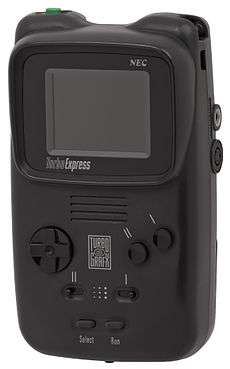
The TurboExpress is a portable version of the TurboGrafx, released in North America in 1991 for $249.99 (the price was briefly raised to $299.99, soon dropped back to $249.99, and by 1992 it was $199.99). It was the most advanced handheld of its time and could play all the TG-16's HuCard games five years before the Genesis Nomad could do the same for Genesis cartridges. Its Japanese equivalent is the PC Engine GT, which was released in Japan on December 1, 1990.[1] It has a 2.6-inch (66 mm) backlit, active-matrix color LCD screen, the most advanced on the market for a portable video game unit at the time. The screen contributed to its high price and short battery life, however. Its keypad layout is similar to that of the original Game Boy, with the unique addition of two "turbo switches" that engage two levels of semi-automatic high-speed controller button re-triggering to assist the player. It shares the capabilities of the TurboGrafx, giving it 512 available colors (9-bit RGB), stereo sound, and the same custom CPU at 7.15909 MHz. The optional "TurboVision" TV tuner included RCA audio/video input, allowing the user to use TurboExpress as a video monitor. The "TurboLink" allowed two-player play. Falcon, a flight simulator, included a "head-to-head" dogfight mode that could only be accessed via TurboLink. However, very few games offered co-op play modes especially designed with the TurboExpress in mind.
NEC Home Electronics released the PC Engine Duo in Japan on September 21, 1991,[1] which combined the PC Engine and the Super CD-ROM² into a single unit. The system can play audio CDs, CD+Gs, CD-ROM² and Super CD-ROM² games as well as standard HuCards. It was launched for the North American market as the TurboDuo in 1992. The American version of Duo was originally bundled with one control pad, an AC adapter, RCA cables, Ys Book I & II (a CD-ROM² title), and a Super CD-ROM² including Bonk's Adventure, Bonk's Revenge, Gate of Thunder and a secret version of Bomberman accessible via an easter egg. The system was also packaged with one random HuCard game which varied from system to system (Dungeon Explorer was the original HuCard pack-in for TurboDuo, although many titles were eventually used, such as Irem's Ninja Spirit and Namco's Final Lap Twin, and then eventually a random pick). The Super System Card required for Super CD-ROM² format games when using the TurboGrafx-CD add-on was built into the Duo, rather than requiring the card to be inserted at all times when playing a Super CD title.
Third-party models
The X1 Twin is a combination of X1 computer and PC Engine. It plays HuCards only. The PC-KD863G, a computer (RGB) monitor with a built-in PC Engine, likewise plays only HuCards. Pioneer Corporation's Pioneer LaserActive supports an add-on module which allows the use of PC Engine games (HuCard, CD-ROM² and Super CD-ROM²) as well as new "LD-ROM²" titles that work only on this device. NEC also released their own LaserActive unit and PC Engine add-on module, under an OEM license.[18] A total of eleven LD-ROM2 titles were produced, with only three of them released in North America.
The TurboGrafx-16 was released in South Korea by a third party under the name Vistar 16.[19]
Various PC Engine Shuttle clones exist, with varying levels of compatibility with original PC-Engine games. One of the more common types is the "PC Boy".
The PC Engine was never officially released in continental Europe, but some companies imported them and made SCART conversions on a moderate scale. In France, Sodipeng imported Japanese systems and added an RGB Cable called "AudioVideo Plus Cable". This mod improved the original video signal quality extensively and made the consoles work with SECAM televisions. In Germany, several importers sold converted PC Engines with PAL RF as well as RGB output. The connectors and pinouts used for the latter were frequently compatible with the Amiga video port, with two unconnected pins used for the audio channels.
Peripheral compatibility
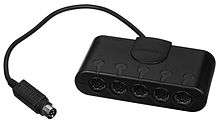
All PC Engine systems support the same controller peripherals, including pads, joysticks and multitaps. Except for the Vistar, Shuttle, GT, and systems with built-in CD-ROM drives, all PC Engine units shared the same expansion connector, which allowed for the use of devices such as the CD-ROM unit, battery backup and AV output.
The TurboGrafx and Vistar units use a different controller port than the PC Engines, but adaptors are available and the protocol is the same. The TurboGrafx offers the same expansion connector pinout as the PC Engine, but has a slightly different shape so peripherals must be modified to fit.
The Arcade Card Pro is designed for the original CD-ROM² System add-on, adding the 2304 kB of RAM required by Arcade CD-ROM² games. The Arcade Card Duo is for the Super CD-ROM² System and the PC-Engine Duo/R/RX consoles and adds 2048 kB RAM, since those systems already have 256K of RAM built-in.
The various CD-ROM game types are:
- CD-ROM² : Standard CD-ROM game. Runs on all CD-ROM² Systems without any additional requirements
- Super CD-ROM² : Requires a Super System Card to work on the original CD-ROM² System. No card is required for Super CD-ROM² and Duo consoles.
- Arcade CD-ROM² : Requires an Arcade Card Pro on the original CD-ROM² System, or an Arcade Card Duo on the Super CD-ROM² and Duo consoles.
Video formats
All PC Engine hardware outputs video in NTSC format, including the European TurboGrafx; it generates a PAL-compatible video signal by using a chroma encoder chip not found in any other system in the series.
Technical specifications
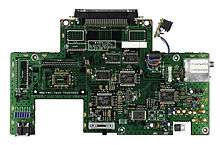
The PC Engine is a relatively compact video game console, owing to an efficient three-chip architecture and its use of small ROM cartridges called HuCards (Turbo Chips in North America). Hudson Soft developed the HuCard (Hudson Card) from the Bee Card technology it piloted on the MSX. HuCards are about the size of a credit card, but slightly thicker. They are very similar to the My Card format utilized for certain games released on the SG-1000/SC-3000 and the Mark III/Master System. The largest Japanese HuCard games were up to 20 Mbit in size. All PC Engine consoles can play standard HuCards, including the PC Engine SuperGrafx (which has its small library of exclusive HuCards).
With the exception of the budget-priced PC Engine Shuttle, the portable PC Engine GT and the PC-KD863G monitor, every PC Engine console is also capable of playing CD-ROM² discs, provided the console is equipped with the required CD-ROM drive and System Card. The SuperGrafx and PC Engine LT both required additional adapters to work on the original CD-ROM² System and Super CD-ROM² respectively, whereas the Duo consoles had the CD-ROM drive and Super System Card integrated into them (as did the Super CD-ROM² player). Some unlicensed CD games by Games Express can only run on Duo consoles, due to their games requiring both a special System Card packaged with the games and the 256 kB of RAM built into the Duo.
The console's CPU is a Hudson Soft HuC6280 8-bit microprocessor operating at 1.79 MHz and 7.16 MHz. It features integrated bank-switching hardware (driving a 21-bit external address bus from a 6502-compatible 16-bit address bus), an integrated general-purpose I/O port, a timer, block transfer instructions, and dedicated move instructions for communicating with the HuC6270A VDC. Its 16-bit graphics processor and video color encoder chip were also developed by Hudson Soft.[20] It holds 8 kB of work RAM and 64 kB of video RAM.
Display
Resolution
- X (Horizontal) Resolution: variable, maximum of 565 (programmable to 282, 377 or 565 pixels, or as 5.3693175 MHz, 7.15909 MHz, and 10.738635 MHz pixel dot clock)[21] Taking into consideration overscan limitations of CRT televisions at the time, the horizontal resolutions were realistically limited to something a bit less than what the system was actually capable of. Consequently, most game developers limited their games to either 256, 352, or 512 pixels in display width for each of the three modes.[22]
- Y (Vertical) Resolution: variable, maximum of 242 (programmable in increments of 1 scanline). It is possible to achieve an interlaced "mode" with a maximum vertical resolution of 484 scanlines by alternating between the two different vertical resolution modes used by the system. However, it is unknown, at this time, if this interlaced resolution is compliant with (and hence displayed correctly on) NTSC televisions.
- The majority of TurboGrafx-16 games use 256×239,[21] though some games, such as Sherlock Holmes: Consulting Detective did use 512×224.
Color
- Colors available: 512 (9-bit)
- Colors onscreen: Maximum of 482 (241 background, 241 sprite)
- Palettes: Maximum of 32 (16 for background tiles, 16 for sprites)
- Colors per palette: 16 per background palette (color entry #0 of each background palette must be the same), and 15 per sprite palette (plus transparent, which is displayed as an actual color in the overscan area of the screen)
Sprites
- Simultaneously displayable: 64 on-screen, 16 (256 sprite pixels) per scanline
- Sizes: 16×16, 16×32, 16×64, 32×16, 32×32, 32×64
- Palette: Each sprite can use up to 15 unique colors (one color must be reserved as transparent) via one of the 16 available sprite palettes.
- Layers: The HuC6270A VDC was capable of displaying one sprite layer. Sprites could be placed either in front of or behind background tiles by manipulating a bit which caused indirect pixel color entry #0 of the background tile(s) to act as transparent.
Tiles
- Size: 8×8
- Palette: Each background tile can use up to 15 unique colors via one of the 16 available background palettes and 1 shared color (BG color #0) for a total of 16 colors per tile. The first color entry of each background subpalette is ignored. Instead, color #0's RGB value is shown in its place (the common/shared color). When a specific sprite is set to show behind the BG layer via the priority bit, all tiles that use relative color #0 (of 16) will not show BG color #0. But instead will show the sprite pixel (if not opaque).
- Layers: The HuC6270A VDC was capable of displaying one background layer.
Audio capacity
- Six wavetable synthesis audio channels, programmable through the HuC6280A CPU.
- Each channel had a frequency of 111.87 kHz for single cycle of 32 samples (while not in D/A mode) with a bit depth of 5 bits. Each channel also was allotted 20 bytes (32×5 bits) of RAM for sample data.
- The waveforms were programmable so the composers were not limited to the standard selection of waveforms (square, sine, sawtooth, triangle, etc.). But the use of standard waveforms, and semi-standard forms, such as a 25% pulse wave were used fairly often.
- The first two audio channels (1 and 2) were capable of LFO when channel #2 was used to modulate channel #1 with vibrato. In theory, this could also be used to perform an FM operation, though due to other limitations, this was never done (note: LFO, like FM works by modifying an audible waveform (carrier oscillator) with an inaudible waveform (modulator oscillator), but LFO's modulator is subsonic rather than sonic (FM), so LFO will not change the carrier's timbre, just its behavior, and as a result, LFO does not really sound anything like FM.)
- The final two audio channels (5 and 6) were capable of Noise generation.
- Optional software enabled Direct D/A which allows for sampled sound to be streamed into any of the six PSG audio channels. When a channel is in D/A mode the frequency is as fast as the CPU can stream bytes to the port, though in practicality it is limited to 6.99 kHz when using the TIMER interrupt with its smallest loop setting (1023 cpu cycles) or 15.7 kHz using the scanline interrupt.
- There is a method that combines two channels in DDA mode to play back 8-bit, 9-bit, or 10-bit samples.
- The addition of the CD-ROM peripheral adds CD-DA sound, and a single ADPCM channel to the existing sound capabilities of the PC Engine.
Region protection

With HuCards, a limited form of region protection was introduced between markets which for the most part was nothing more than running some of the HuCard's pinout connections in a different arrangement. There were several major after-market converters sold to address this problem, and were sold predominantly for use in converting Japanese titles for play on a TG-16. In the Japanese market, NEC went further by adding a hardware level detection function to all PC Engine systems that detected if a game was a U.S. release, and would then refuse to play it. The only known exception to this is the U.S. release of Klax which did not contain this function. The explanation commonly given for this by NEC officials is that most U.S. conversions had the difficulty level reduced, and in some cases were censored for what was considered inappropriate content, and consequently, they did not want the U.S. conversion to re-enter the Asian market and negatively impact the perception of a game. With some minor soldering skills, a change could be made to PC Engines to disable this check.[23] The only Japanese games that could not be played on a U.S. system using one of these converters were the SuperGrafx titles which could only be played on a SuperGrafx.
There was no region protection on TurboGrafx-CD and CD-ROM² System games.
CD hardware technical specifications and information
- Oki MSM5205 ADPCM chip with variable speed input clock, and 64 kB DRAM for audio sample storage. Only one channel of 4-bit compressed audio (decompresses to 12-bit, top 10 bits output through DAC) was supported.[24] It supports a sampling rate of up to 32.088 kHz.[25]
- Programmable, timer controlled, electronic volume attenuator to fade-out the CD-DA and ADPCM audio channels together or individually.
- The PC-Engine CD-ROM interface tray has 64 kB of DRAM for storage of program code and data loaded from the CD.
- The "System Card" contains the BIOS program used to boot CD media and provides functions for software to access CD hardware through a standardized interface. Later System Cards had extra RAM and updates to the BIOS.
- The Duo series has the same BIOS ROM (v3.00) and RAM (256 kB total) as a PC-Engine system equipped with a Super System Card. The Duo implements the memory as a single 256 kB SRAM chip rather than the split 64 kB DRAM / 192 kB SRAM.
- The list of known CD-ROM BIOS revisions are:
- v1.00 – First release (System Card, came with the first versions of the PC-Engine CD-ROM² Interface Unit)
- v2.00 – Upgrade (System Card, came with later versions of the Interface Unit)
- v2.10 – Upgrade (System Card, came with even later versions of the Interface Unit or sold separately)
- v3.00 – Final release (built into several products and available as a Super System Card – see below)
- The list of known System Card releases are:
- System Card v1.00 – First release. Came packaged with the original PC-Engine CD-ROM² System.
- System Card v2.00 – BIOS update. This adds support for CD+G discs.
- System Card v2.10 – BIOS update. Auto disc change detection is implemented. Was the first System Card that was sold separately from the add-on.
- System Card v3.00 (aka. Super System Card) – 1.5 Mbit RAM (192 kB) – RAM upgrade and BIOS update. This expands the RAM available for the CD-ROM unit to 256 kB when including the existing built in DRAM. It also offers a final BIOS update to v3.00. The PC-Engine Duo (Turbo Duo in North America) had 256 kB of RAM and the same v3.00 BIOS built into the system. Games developed for this System Card bore the "Super CD-ROM² System" mark and could not be played using an older System Card.
- Arcade Card Duo – 16 Mbit RAM (2048 kB) – RAM upgrade exclusively for the Super CD-ROM² System and PC Engine Duo consoles. This greatly expands the RAM available to 2048 kB. The BIOS revision was unchanged from v3.00. Games developed for the Arcade Card Duo/Pro bore the "Arcade CD-ROM²" mark, and could not be played using prior System Cards. The Arcade Card Pro includes the extra 192 kB needed for the original CD-ROM² System
- Arcade Card Pro – 17.5 Mbit RAM (2240 kB as 2 MB+192 kB) – RAM upgrade for the original CD-ROM² System. This greatly expands the RAM available to 2240 kB. The BIOS revision was unchanged from v3.00. The Arcade Card Pro combines the functions of the Super System Card and the Arcade Cad Duo into one unit. The 2 MB of RAM is accessed through ports or units of single 8 kB banks and is intended for graphics data storage rather than program code; its flexible addressing system allows for rapid transfer of data to VRAM. While intended and marketed for the original CD-ROM² System, it's actually compatible with Super CD-ROM² add-on and all Duo consoles without any issues.
- Games Express CD Card – Bootleg System Card. This was released by Hacker International for play of unlicensed Games Express CD games. The GECD Card is essentially a dongle; a BIOS v3.00 based machine (like a Duo or a Super CD-ROM²) is required for running those games.
Corresponding CD-ROM products
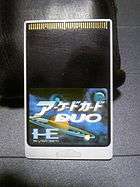 |
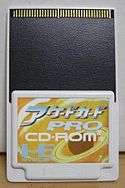 |
| Arcade Card Duo (left) and Arcade Card Pro | |
- CD-ROM² System – Consists of two components: a compact CD player (CDR-30) and the Interface Unit (IFU-30), which connects the CD player into the PC Engine console itself. These were sold separately or as part of a bundle. The Interface Unit also stores save data and provides a common power supply for the PC Engine and the CD player. A System Card is required for the PC Engine to access the functions of the CD player. Later revisions of both, the CD player (CDR-30A) and the Interface Unit (IFU-30A), featured improved disc reading capabilities.
- System Card – The original CD-ROM² System Card included with the Interface Unit. The System Card underwent a few slight revisions, with Version 1.0 being the original model, followed by Version 2.0 (which adds CD+G support) and Version 2.1 (which auto-detects discs). Only Version 2.1 was sold as a stand-alone unit.
- ROM² Adaptor (RAU-30) – A cable with two large ends that allows a PC Engine SuperGrafx (PI-TG4) console to be connected into the CD-ROM² Interface Unit.
- Super System Card (PI-SC1) – An upgraded System Card that changes the BIOS of the CD-ROM² System to Version 3.0 and adds the 192kb of SRAM required to play Super CD-ROM² format discs.
- Super CD-ROM² (PI-CD1) – An upgraded version of the CD-ROM² System add-on that combines the functions of the Interface Unit, CD-ROM player and Super System Card into one unit.
- PC Engine Duo (PI-TG8) – A PC Engine console with a built-in Super CD-ROM² unit.
- Super ROM² Adaptor (PI-AD8) – An adapter that allows the PC Engine LT (PI-TG9) to be connected into the Super CD-ROM² unit.
- PC Engine Duo-R (PI-TG10) – A redesigned version of the PC Engine Duo.
- PC Engine Duo-RX (PCE-DUORX) – The third version of the PC Engine Duo.
- Arcade Card Duo (PCE-AC1) – A RAM expansion card that adds the 16 Megabits of DRAM required to run Arcade CD-ROM² discs on any Super CD-ROM² and PC Engine Duo systems.
- Arcade Card Pro (PCE-AC2) – Combines the functions of the Arcade Card Duo and the Super System Card into one card. Designed and marketed primarily for the original CD-ROM² System.
Drive unit
- Single-speed CD-ROM drive, managed by an NEC microcontroller and using the SCSI-I interface.
- Transfer rate of 150 kB/s.
Reception
In Japan, the PC Engine was very successful, and at one point was the top-selling console in the nation.[26] In North America and Europe the situation was reversed, with both Sega and Nintendo dominating the console market at the expense of NEC. Initially, the TurboGrafx-16 sold well in the U.S., but eventually it suffered from lack of support from third-party software developers and publishers.
In 1990, ACE magazine praised the console's racing game library, stating that, compared to "all the popular consoles, the PC Engine is way out in front in terms of the range and quality of its race games."[27] Reviewing the Turbo Duo model in 1993, GamePro gave it a "thumbs down". Though they praised the system's CD sound, graphics, and five-player capability, they criticized the outdated controller and the games library, saying the third party support was "almost nonexistent" and that most of the first party games were localizations of games better suited to the Japanese market.[28] In 2009, the TurboGrafx-16 was ranked the 13th greatest video game console of all time by IGN, citing "a solid catalog of games worth playing," but also a lack of third party support and the absence of a second controller port.[29]
Legacy
In 1994, NEC released a new console, the Japan-only PC-FX, a 32-bit system with a tower-like design; it enjoyed a small but steady stream of games until 1998, when NEC finally abandoned the video games industry. NEC would then partner with former rival Nintendo in making the CPU for the Nintendo 64 and Sega, providing a version of its PowerVR 2 Chipset for the Dreamcast.
A number of TurboGrafx-16 and TurboGrafx-CD games were released on Nintendo's Virtual Console download service for the Wii,[30] Wii U, and Nintendo 3DS, including several that were originally never released outside Japan.[31][32] In 2011, ten TurboGrafx-16 games were released on the PlayStation Network for play on the PlayStation 3 and PlayStation Portable in the North American region.
In 2010 Hudson released an iPhone application entitled "TurboGrafx-16 GameBox" which allowed users to buy and play a number of select Turbo Grafx games via in-app purchases.[33]
In 2016, Kanye West announced his 8th solo album would be titled "Turbo Grafx 16".[34][35]
Emulation
Emulation programs for the TurboGrafx-16 exist for several modern and retro operating systems and architectures and are at varying levels of emulation ranging from beta stage, to near perfect emulation of all PC Engine and TurboGrafx-16 formats.
See also
References
- 1 2 3 4 5 6 7 8 9 10 11 12 13 14 http://www.pc-engine.co.uk/?section=systems
- 1 2 Blake Snow (May 4, 2007). "The 10 Worst-Selling Consoles of All Time". GamePro.com. Archived from the original on September 5, 2008. Retrieved May 28, 2007.
- ↑ Guinness World Records Gamer's Edition (2008)
- ↑ "Hudson Entertainment – Video Games, Mobile Games, Ringtones, and More!". Web.archive.org. June 19, 2008. Archived from the original on September 29, 2011. Retrieved July 5, 2011.
- ↑ "Nec PC Engine / Turbografx". September 1, 2000. Retrieved January 26, 2016.
- ↑ Pubs Sodipeng Pc-engine (1990–91) – Le Adra's Blog ! – GAMEBLOG.fr
- ↑ Video Game Trader Magazine (March 16, 2009). "Video Game Trader #3, March 2008". Videogametrader.com. Archived from the original on July 17, 2011. Retrieved July 5, 2011.
- ↑ http://magweasel.com/2009/07/21/i-love-the-pc-engine-fighting-street/
- ↑ http://www.giantbomb.com/no-ri-ko/3030-39939/
- ↑ Top 25 Videogame Consoles of All Time, IGN. Retrieved 2010-06-14.
- ↑ Mark J. P. Wolf (2008), The video game explosion: a history from PONG to Playstation and beyond, ABC-CLIO, p. 119, ISBN 0-313-33868-X, retrieved April 10, 2011
- ↑ "Turbo CD". GameFAQs. Retrieved May 14, 2012.
- ↑ "Toys R Us weekly ad". The Catoosa County News. December 5, 1990. Retrieved 2014-06-17.
- ↑ Steven L. Kent, The Ultimate History of Video Games, p. 413.
- ↑ "Celebrating Software". Computer Gaming World. June 1991. p. 64. Retrieved November 17, 2013.
- ↑ "At the Deadline". GamePro (60). IDG. July 1994. p. 172.
- ↑ "Dead of the Brain 1 & 2". Consolecity.com. June 3, 1996. Retrieved July 5, 2011.
- ↑ "International News". Electronic Gaming Monthly (54). EGM Media, LLC. January 1994. p. 94.
- ↑ Vistar 16
- ↑ "United States patent 5059955".
- 1 2 "Forums.MagicEngine.com". Forums.MagicEngine.com. Retrieved 2011-07-05.
- ↑ "forum". Pcenginefx.com. Retrieved July 5, 2011.
- ↑ "PC Engine Import Mod". GameSX. Retrieved January 11, 2014.
The fix: On Japanese systems, connect pin 29 of the Hu6280 chip to [ground]. That's it.
- ↑ http://webcache.googleusercontent.com/search?q=cache:G7O62_Ggt1sJ:archaicpixels.com/images/f/f8/MSM5205.pdf
- ↑ http://www.ysutopia.net/special/MSM5205.htm
- ↑ "What in the Name of Sam Hill is a PC Engine?". Electronic Gaming Monthly. Ziff Davis (70): 15. May 1995.
- ↑ ACE, issue 34 (July 1990), page 59
- ↑ "System Shopper". GamePro (53). IDG. December 1993. pp. 46–49.
- ↑ "TurboGrafx-16 is number 13". IGN. Retrieved July 5, 2011.
- ↑ "Hudson Entertainment – Video Games, Mobile Games, Ringtones, and More!". Hudsonent.com. Retrieved July 5, 2011.
- ↑ "IGN: GDC 06: Satoru Iwata Keynote". Wii.ign.com. March 23, 2006. Retrieved 2011-07-05.
- ↑ "Virtual Console: Sega and Hudson games are a go! – Nintendo Wii Fanboy". Revolution Fanboy. March 23, 2006. Archived from the original on December 1, 2008. Retrieved July 5, 2011.
- ↑ Cowan, Danny. "Hudson Releases TurboGrafx-16 GameBox Emulator For iOS". Gamasuitra. Retrieved April 6, 2016.
- ↑ "Kanye's Twitter".
- ↑ Byford, Sam. "Kanye West says his new album is called Turbo Grafx 16 and coming this summer". The Verge. Retrieved April 6, 2016.
External links
| Wikimedia Commons has media related to PC Engine. |
- The PC Engine Software Bible software listing including reviews and videos.
- PC-Engine definitive hardware listing for all PC Engine and Turbo Grafx systems.
- Archaic Pixels contains the most extensive compendium of TurboGrafx-16 technical information.
- TurboGrafx-16 overview and review show!
- Video of TurboGrafx-16 and PC Engine hardware and features from FamicomDojo.TV
